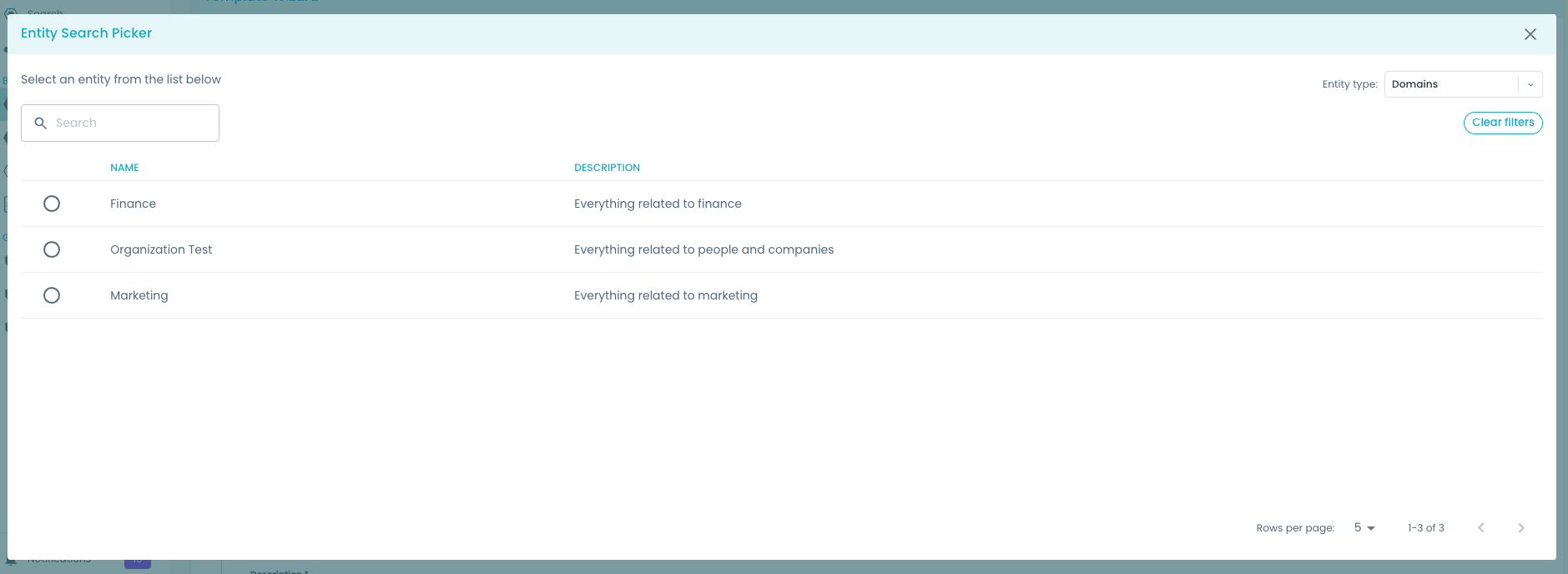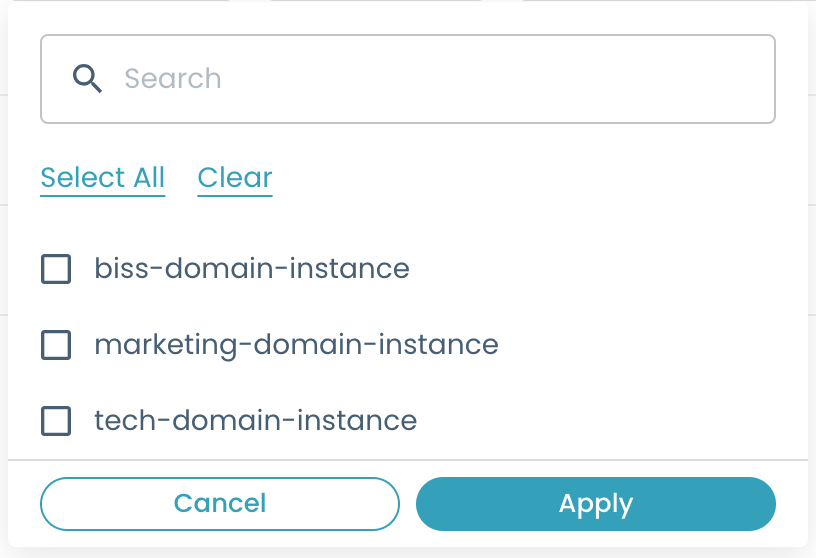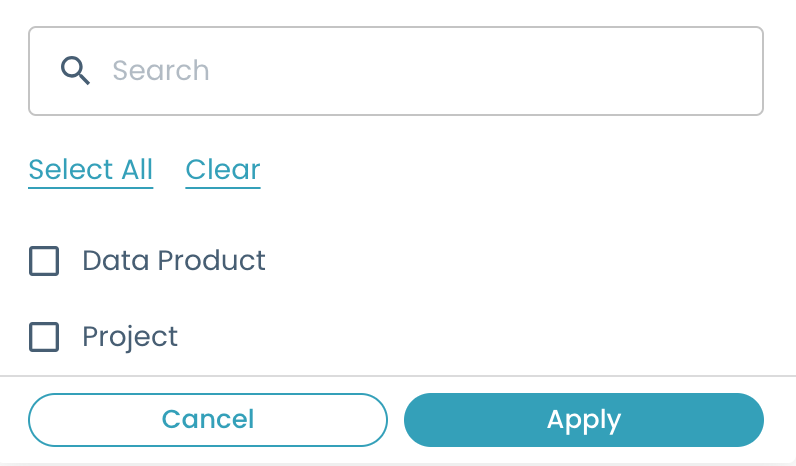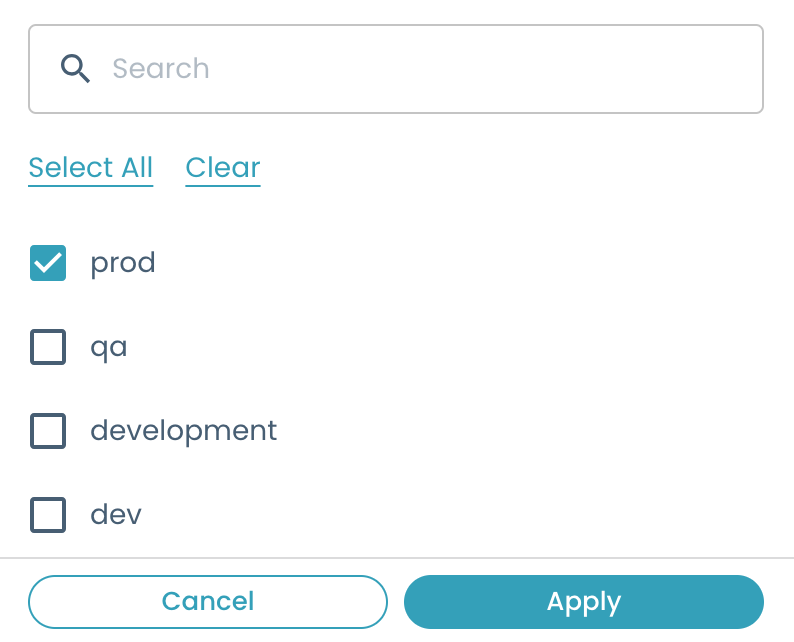Entity Search Picker
Overview
The Entity Search Picker is a highly configurable tool designed to facilitate the selection of entities within the platform. This picker allows users to select one or more entities based on configurable criteria, making it a versatile component in various applications. This documentation outlines the configuration options, functionality, and internal workings of the Entity Picker, to assist developers and template editors in implementing and utilizing the tool effectively.
Configuration
The Entity Search Picker configurations are defined under the ui:options field. Within this last field, you can define the entities property which is a list of objects that are used to configure the Entity Providers: A list of providers used to fetch different kinds of entities to be queried by the user.
The root configuration to use is the following:
entitySearchPicker:
title: Entity Search Picker
ui:field: EntitySearchPicker
ui:options:
entities:
# the list of Entity Providers goes here
Entity Provider
The Entity Provider is a component used by the EntitySearchPicker that is responsible to fetch, filter and render all the data of entities of a specific kind. The generic configuration you can use to define an Entity Provider is the following:
multiSelection: true # see "Selection Mode" section
kind: ${ENTITY_KIND} # the kind of data the Entity Provider is handling (see "Entity Provider Types" section below)
displayField: ${OBJECT_PROPERTY} # the property of the object to show in the EntitySearchPicker after a selection (see "Entities Configuration" section)
returnField: ${RETURNING_FIELD} # "urn", "ref" or "full", it corresponds to the value to be saved in the final catalog-info.yaml file
userFilters: ${FILTERS_LIST} # a list of filters that can be used in the EntitySearchPicker to filter values
filter:
practiceShaper:
kind: ${PRE_FILTER} # it contains a string value used to pre-filter data before rendering the EntitySearchPicker. This value depends on the selected Entity Provider (see "Pre-filtering" section under "Entity Configurations")
columns: # a list of objects describing the columns to display in the table (see "Displayable Columns in the Selection Table" section)
Selection Mode
-
Single Selection: The picker returns the
returnFieldof a single selected entity.
-
Multiple Selection: The picker allows the selection of multiple entities, returning a list of entity URNs or Entity References.


It's possible to return the entity ref or full entity object, instead of URN, by changing the returnField in the configuration.
It is also possible to define also the boolean field ui:.allowArbitraryValues that, if set to false, prevents the users from typing arbitrary values outside the list of selectable items. This specifies if the field can be edited manually by the user. If omitted, by default it will be false (not editable by the user).
Entity Provider Types
The picker can be configured to allow the selection of these entities by default:
- Domains
- Systems
- Resources
- Consumables
- Data Contracts
It is possible to choose your entities under the ui:options parameter with entities attribute. There you can set more than one entity type, and for each one, you can define a specific configuration.
Entity Provider Configuration
Each entity provider type that can be used in the picker must be configured to fetch the appropriate entities. Some fields are configured the same way among entity providers, while fields regarding filtering are specific for each entity type.
Display name
A string that defines the label shown as a prefix when an entity is selected and it's used as the name on the entity kind selector (pluralized), inside the dialog window. The entity kind is used as a fallback. For example:
displayName: Consumables

Display field
It defines which property is shown for the selected entities. This property is processed as a Nunjucks value, so it can contain variables and expressions. It represents which label is shown for selected entities.
displayField: '{{spec.mesh.name}}'
When not defined, the field entity.spec.mesh.name is used, and in case it is not defined, the fallback value is entity.metadata.name or name for Consumable Provider.
Return field
With this configuration, it is possible to choose which value is returned for the selected entities:
-
urn: the Witboost global URN (this is the default value) e.g.:
urn:dmb:dmn:finance -
ref: entity reference used inside the Builder module e.g.:
domain:default/finance -
full: all properties of the object e.g.:
{
"apiVersion": "backstage.io/v1alpha1",
"kind": "Domain",
"metadata": {
"name": "finance",
"description": " Everything related to finance",
"links": [
{
"url": "http://example.com/domain/finance",
"title": "Finance Domain"
}
]
},
"spec": {
"owner": "group:datameshplatform",
"mesh": {
"name": "Finance"
}
}
}or for
Consumableobject:{
"_computedInfo": {
"urn": "urn:dmb:cmp:sub-domain-a:dpwithimpala:0:s3-cdp-output-portasdasd-6",
"domain": {
"id": "urn:dmb:dmn:subdomaina",
"name": "sub-domain-A"
},
"system": {
"id": "urn:dmb:dp:sub-domain-a:dpwithimpala:0",
"name": "DPWithImpala"
}
},
"id": "urn:dmb:cmp:sub-domain-a:dpwithimpala:0:s3-cdp-output-portasdasd-6",
"kind": "outputport",
"name": "S3 CDP Output Portasdasd 6",
"tags": [],
"text": "",
"title": "S3 CDP Output Portasdasd 6",
"domain": "sub-domain-A",
"version": "0.0.0",
"location": "urn:dmb:cmp:sub-domain-a:dpwithimpala:0:s3-cdp-output-portasdasd-6",
"platform": "CDP on AWS",
"specific": {
"acl": {
"users": [],
"owners": []
},
"bucket": "asdasd",
"folder": "asdasd",
"cdpEnvironment": "asdasd"
},
"dependsOn": [],
"startDate": "2023-09-28T11:02:24.233Z",
"documentId": "urn:dmb:cmp:sub-domain-a:dpwithimpala:0:s3-cdp-output-portasdasd-6:dev",
"sampleData": {},
"technology": "S3",
"description": "asdasd",
"environment": "dev",
"creationDate": "2023-09-28T11:02:24.233Z",
"dataContract": {
"SLA": {
"upTime": null,
"timeliness": null,
"intervalOfChange": null
},
"schema": [],
"endpoint": null,
"termsAndConditions": null
},
"outputPortType": "Files",
"semanticLinking": [],
"deploymentUnitId": "urn:dmb:dp:sub-domain-a:dpwithimpala:0",
"useCaseTemplateId": "urn:dmb:utm:aws-cdp-outputport-s3-template:0.0.0",
"fullyQualifiedName": null,
"processDescription": null,
"dataSharingAgreements": {
"billing": null,
"purpose": null,
"security": null,
"lifeCycle": null,
"limitations": null,
"intendedUsage": null,
"confidentiality": null
},
"infrastructureTemplateId": "urn:dmb:itm:aws-cdp-outputport-s3-provisioner:0"
}
For Consumable and Data Contracts entity types, you cannot return an entity reference, because it does not exist. If ref is selected, the Witboost global URN will be given.
Pre-Filtering
Usually, you would like to limit the values that the user can select. This can be done by defining a pre-filter for the entity type. This is useful when you want to choose among particular kinds of systems, as the ones defined in the Practice Shaper, or among domains that are instances of a particular DomainType. This is done by defining a filter object under the entity configuration.
Every entity type has its own filter options:
Domain
When you want the users to select a domain instance entity (kind: Domain) you can refine what set of domains the user can choose from. The following table describes the filter options available for Domains:
| Option | Type | Description |
|---|---|---|
| kind | string | One of: |
| - compatibleWithType - See below. | ||
| - instanceOf - See below. | ||
- compatibleWithCurrentTemplate - Takes the SystemType/ComponentType reference, which is the target of the generates relation of the current creation template, and applies the same logic of compatibleWithType. | ||
| compatibleWithType | string[] | (Required when kind is compatibleWithType) Accepts the reference of a Practice Shaper entity type (e.g., SystemType, ComponentType). Filters domain instances whose DomainType (spec.instanceOf property) is the parent domain (directly or transitively) of the provided type. |
| instanceOf | string[] | (Required when kind is instanceOf) Reference of a DomainType in the Practice Shaper. Filters domain instances that are instances of the provided type. |
Examples:
-
compatibleWithCurrentTemplatepre-filter:Let's imagine the
DomainEntity Provider is used in a template that generates an Output Port (generates: componenttype:default/outputport). If no pre-filter is present or only thecompatibleWithCurrentTemplatepre-fillter is set, the end user will see only the domain the Output Port is binded to, or, if no domain is found for that Output Port, it will be showed only the domain binded to the Output Port's system.The pre-filter to set will be the following:
filter:
practiceShaper:
kind: compatibleWithCurrentTemplate -
compatibleWithTypepre-filter:If you want to specify a
ComponentTypeorSystemTypethe domain must be binded to, you can do it by using the following configuration:filter:
practiceShaper:
kind: compatibleWithType
compatibleWithType:
- componenttype:default/outputport
- systemtype:default/projectIn this way, there will be shown only the domain instances binded to the 'Output Port' component type and 'Project' system type.
-
instanceOfpre-filter:If you want to specify a list of
DomainTypes to be instantiated by domain instances, you can do it with the following configuration:filter:
practiceShaper:
kind: instanceOf
instanceOf:
- domaintype:default/department
- domaintype:default/business-domain
System
When you want the users to select a system instance entity (kind: System) you can refine what set of systems the user can choose from. The following table describes the filter options available for Systems:
| Option | Type | Description |
|---|---|---|
| kind | string | One of: |
| canBeParentOfType - See below. | ||
| instanceOf - See below. | ||
canBeParentOfCurrentInstance (Default) - Takes the ComponentType reference, target of the generates relation of the current creation template, and applies the same logic of canBeParentOfType. | ||
| canBeParentOfType | string[] | Accepts the reference of a ComponentType. Filters system instances whose SystemType (spec.instanceOf property) is the target of a partOf relation having as a source the provided ComponentType. |
| instanceOf | string[] | Reference of a SystemType in the Practice Shaper. Filters system instances that are instances of the provided type. |
Examples:
-
canBeParentOfCurrentInstancepre-filter:Let's imagine the
SystemEntity Provider is used in a template that generates an Output Port (generates: componenttype:default/outputport). If no pre-filter is present or just thecanBeParentOfCurrentInstancepre-filter is set, the end user will see only the system the Output Port is binded to.filter:
practiceShaper:
kind: canBeParentOfCurrentInstance -
canBeParentOfTypepre-filter:If you want to specify a
ComponentTypethe system must be binded to, you can do it by using the following configuration:filter:
practiceShaper:
kind: canBeParentOfType
canBeParentOfType:
- componenttype:default/project-component -
instanceOfpre-filter:If you want to specify a list of
SystemTypes the systems must be instance of, you can do it with the following configuration:filter:
practiceShaper:
kind: instanceOf
instanceOf:
- systemtype:default/dataproduct
Consumable
When you want the users to select a consumable instance entity (kind: Consumable) you can refine what set of component the user can choose from. The following table describes the filter options available:
| Option | Type | Description |
|---|---|---|
| kind | string | One of: |
| canBeReadFrom - See below. | ||
canBeReadFromCurrentInstance (Default) - Takes the ComponentType reference, target of the the generates relation of the current creation template, and applies the same logic of canBeReadFrom | ||
| canBeReadFrom | string | Accepts the reference of a ComponentType. Filters consumable components and subcomponents whose type is one among the resource types readable from the provided component type, based on the Practice Shaper. |
Example:
-
canBeReadFromCurrentInstancepre-filter:Let's imagine the
ConsumableEntity Provider is used in a template that generates an Output Port (generates: componenttype:default/outputport). If no pre-filter is present or just thecanBeReadFromCurrentInstancepre-fillter is set, you will see only the components/sub-components instances the Output Port can read from.filter:
practiceShaper:
kind: canBeReadFromCurrentInstance -
canBeReadFrompre-filter:If you want to specify a
ComponentTypefrom which component instances can read, you can do it by using the following configuration:filter:
practiceShaper:
kind: canBeReadFrom
canBeReadFrom: componenttype:default/outputportIn the above example, the
componenttype:default/outputportreads from two other ComponentTypes:componenttype:default/workloadandcomponenttype:default/storage. Consequently, you will see in the EntitySearchPciker only the components that are instances of the before-mentioned types and that are consumable too.
Data Contracts
When you want the users to select a data contract (kind: DataContract, learn more about Data Contracts) you need to refine what set of data contracts the user can choose from. The following table describes the filter options available:
| Option | Type | Description |
|---|---|---|
| system | string | The nunjucks value of the system picker. Data Contracts will be fetched from that system. If not present, all data contracts present in Witboost are fetched. |
If the pre-filter system is set, it will override the system filter in the user filters. As a consequence, the user will not display the system filter in the EntitySearchPicker, even if he set it in the template.
Example:
-
systempre-filter:Let's imagine the
DataContractEntity Provider is used in a template that generates an Output Port (generates: componenttype:default/outputport). In order to choose data contracts, you need to use the following configuration:dataContract:
title: Data Contracts
description: Choose Data Contracts
ui:field: EntitySearchPicker
ui:options:
multiSelection: false
entities:
- type: DataContract
returnField: urn # or full
filter:
system: '{{systemPickerName}}'
userFilters:
- search
- system # this will not be shown to the userIn this way, the user will see the data contracts of the system selected in the picker named
systemPickerName.
If the user wants to see all the data contracts present in Witboost, he can set the system filter in the user filters:
dataContract:
title: Data Contracts
description: Choose Data Contracts
ui:field: EntitySearchPicker
ui:options:
multiSelection: false
entities:
- type: DataContract
returnField: urn # or full
userFilters:
- search
- system
Filters Usable by End Users
These are the filters that end users can apply to refine their selection within the user interface. The template developer can choose which filters to make available to end users. Common filters include:
- search: filter elements matching with
spec.mesh.name,metadata.nameorname; this filter is available to all the Entity Providers. - domain: filter elements matching the
domainproperty; this filter is available to System and Consumable Entity Providers.
- type: filter elements matching the
typeproperty; this filter is available only to System Entity Provider.
- system: filter elements matching the selected system URN property; this filter is available only to Consumable Entity Provider.

- environment: filter elements matching the
environmentproperty; this filter is available only to Consumable Entity Provider.
By default, no filters are shown, if not specified.
Displayable Columns in the Selection Table
Template developers can choose to display a set of columns in the entity selection table. This customization enhances the user's ability to view pertinent information. You can show any number of additional columns by referencing fields of the selected entity (even using Nunjucks to perform transformations).
To define the additional columns, you can leverage the following configuration fields:
nameto define the column name displayed in the table;pathto define which value to show. The values in double brackets will be resolved with the values from the entity using Nunjucks. It is important to enforce the string type for this field inside the yaml by using the single quotes as shown to avoid errors;valuethat can be used as an alternative topathto choose among two default values:nameanddescription. These are shortcuts for the most common fields to display.
Example:
columns:
- name: name
path: '{% if spec.mesh.name %}{{spec.mesh.name}}{% else %}{{metadata.name}}{% endif %}'
- name: description
value: description
- name: owner
path: '{{spec.owner}}'
- name: tags
path: '{% for tag in spec.mesh.tags %}{{tag.tagFQN}}{{', ' if not loop.last }}{% endfor %}'
Example Use Cases
Here are a few examples illustrating how the Entity Search Picker can be configured and utilized in real-world scenarios:
Single Selection
In this example, it's possible to select one entity among Domain, Resource, and System.
singleEntitySearchPicker:
title: Entity Search Picker
description: single entity search
ui:field: EntitySearchPicker
ui:options:
multiSelection: false
entities:
- type: Domain
displayName: Domain
displayField: '{{spec.mesh.name}}'
returnField: urn
userFilters:
- search
columns:
- name: name
path: '{{spec.mesh.name}}'
- name: description
value: description
- type: Resource
displayName: Resource
displayField: '{{spec.mesh.name}}'
returnField: urn
userFilters:
- search
columns:
- name: name
path: '{{metadata.name}}'
- type: System
displayField: '{{spec.mesh.name}}'
returnField: ref
filter:
practiceShaper:
kind: canBeParentOfCurrentInstance
userFilters:
- search
- domain
- type
columns:
- name: name
path: '{{spec.mesh.name}}'
- name: owner
path: '{{spec.owner}}'
Multiple Selection
In this example, it's possible to select more entities between Domain and System.
multipleEntitySearchPicker:
title: Multiple Entity Search Picker
description: multiple Entity Search
ui:field: EntitySearchPicker
ui:options:
multiSelection: true
entities:
- type: Domain
displayName: Domains
displayField: '{{spec.mesh.name}}'
returnField: ref
filter:
practiceShaper:
kind: instanceOf
instanceOf:
- domaintype:default/department
- domaintype:default/business-domain
userFilters:
- search
- type: System
displayName: Systems
displayField: '{{spec.mesh.name}}'
returnField: full
userFilters:
- type
columns:
- name: name
value: name
- name: tags
path: '{% for tag in spec.mesh.tags %}{{tag.tagFQN}}{{", " if not loop.last }}{% endfor %}'
Migration
This section is intended to help you in migrating the current instances of the ReadsFromPicker and EntityPicker to the new EntitySearchPicker. Consider also to migrate the before-mentioned pickers also in the edit-template to be consistent.
Entity Picker - Domain field
The EntityPicker used with domain type can be replaced safely with the following configuration:
domain:
title: Domain
type: string
description: The Domain of the Data Product.
ui:field: EntitySearchPicker
ui:options:
multiSelection: false
entities:
- type: Domain
displayName: Domain
displayField: '{{spec.mesh.name}}'
returnField: ref
userFilters:
- search
filter:
practiceShaper:
kind: compatibleWithType
compatibleWithType:
- systemtype:default/dataproduct
columns:
- name: name
path: '{{metadata.name}}'
- name: description
value: description
Entity Picker - System field
The EntityPicker used with system type can be replaced safely with the following configuration:
dataproduct:
title: Data Product
description: Data Product
ui:field: EntitySearchPicker
ui:options:
multiSelection: false
entities:
- type: System
displayField: '{{spec.mesh.name}}'
returnField: ref
filter:
practiceShaper:
kind: instanceOf
instanceOf:
- systemtype:default/dataproduct
userFilters:
- search
- domain
- type
columns:
- name: name
path: '{{spec.mesh.name}}'
- name: owner
path: '{{spec.owner}}'
ReadsFrom Picker
The readsFrom Picker can be replaced with the following configuration:
readsFrom:
title: Reads from
type: array
ui:field: EntitySearchPicker
ui:options:
multiSelection: true
entities:
- type: Consumable
displayField: '{{name}}'
returnField: urn
filter:
practiceShaper:
kind: canBeReadFrom
canBeReadFrom: componenttype:default/workload
userFilters:
- search
- domain
- system
- environment
columns:
- name: name
path: '{{name}}'
- type: Resource
displayName: Resource
displayField: '{{spec.mesh.name}}'
returnField: urn
userFilters:
- search
columns:
- name: name
path: '{{metadata.name}}'
Remote Entity Provider
The Entity Search Picker now supports fetching entities from external APIs using the Remote Entity Provider. This functionality allows you to integrate with microservices or external systems to provide entity selection options.
Configuration
To use the remote entity provider, use the "type: Remote". Here's an example
entitySearchPicker:
title: Remote Entity Picker
ui:field: EntitySearchPicker
ui:options
entities:
- type: Remote
displayName: Remote
fieldsToSave: # Optional
- id
- name
- description
columns: # Optional
- name: 'Name'
path: '{{name}}'
- name: 'Description'
path: '{{description}}'
displayField: '{{name}}'
userFilters: ['search'] # Optional, currently only 'search' is supported
apiSpec:
retrieval:
baseUrl: 'https://your-api.example.com'
path: '/api/entities'
method: 'POST' # Optional, defaults to POST
params: # Optional query parameters
areaType: 'marketing'
API Response Format
The external API should return a JSON response with an array of entities. Each entity should be an object with the fields you want to use for selection and display.
Example API response:
{
"data": [
{
"id": "ms-001",
"name": "User Service",
"description": "Handles user authentication and management",
"type": "microservice",
"status": "active"
},
{
"id": "ms-002",
"name": "Payment Service",
"description": "Processes payments and transactions",
"type": "microservice",
"status": "active"
}
]
}
Enable Witty Autocomplete
You can enable AI-powered suggestions in the EntitySearchPicker by setting wittySuggestions.enabled = true. For a full example and more details, see the Witty Autocomplete Agent.